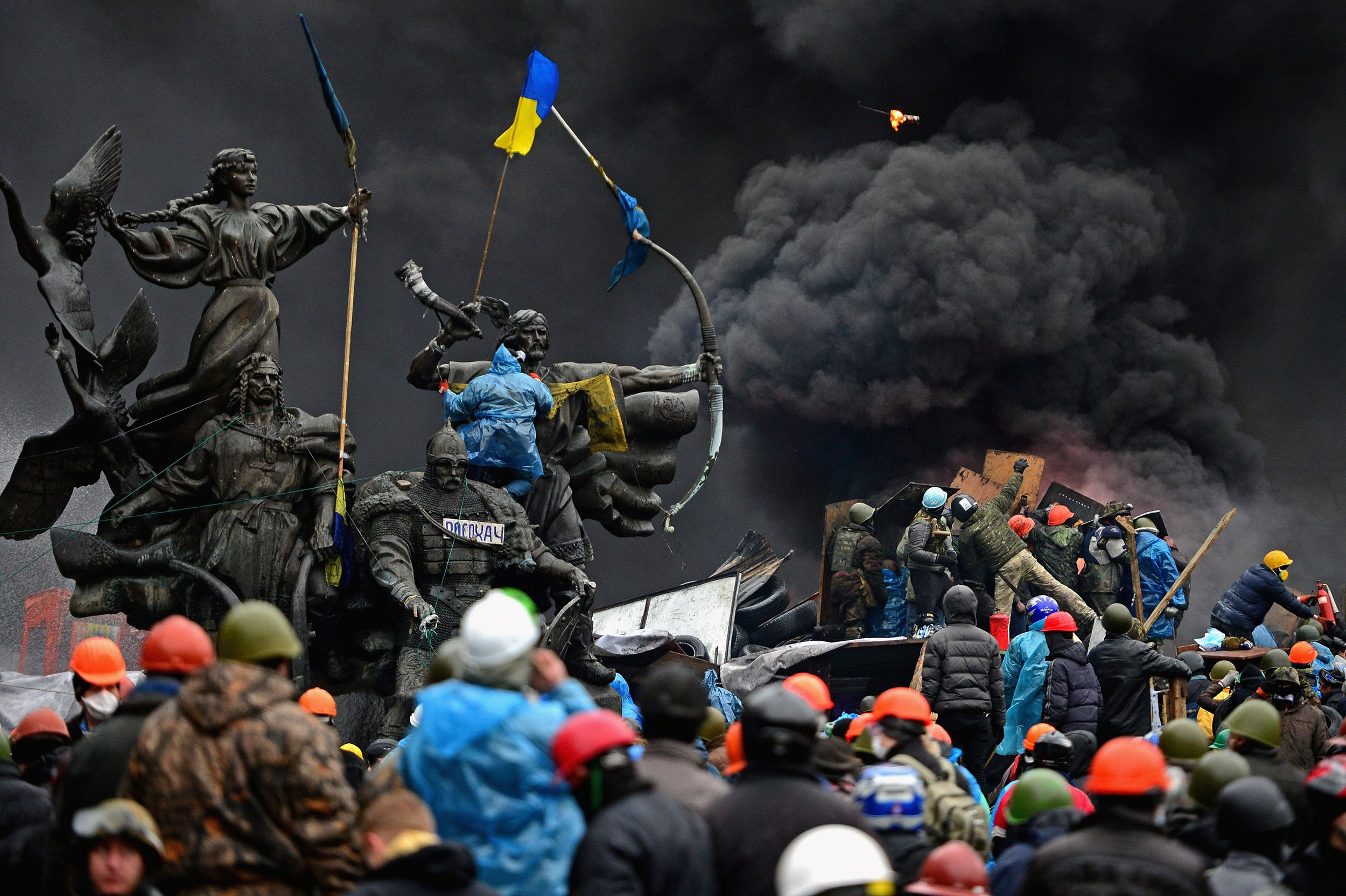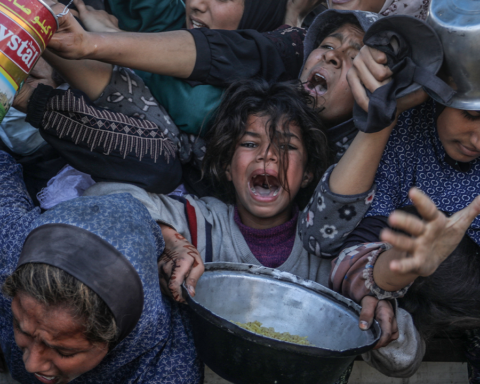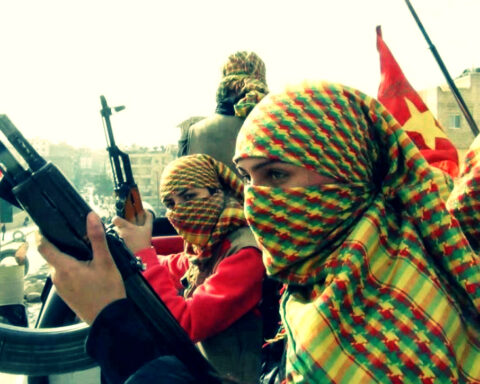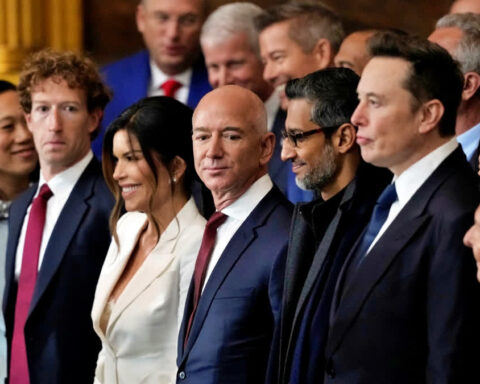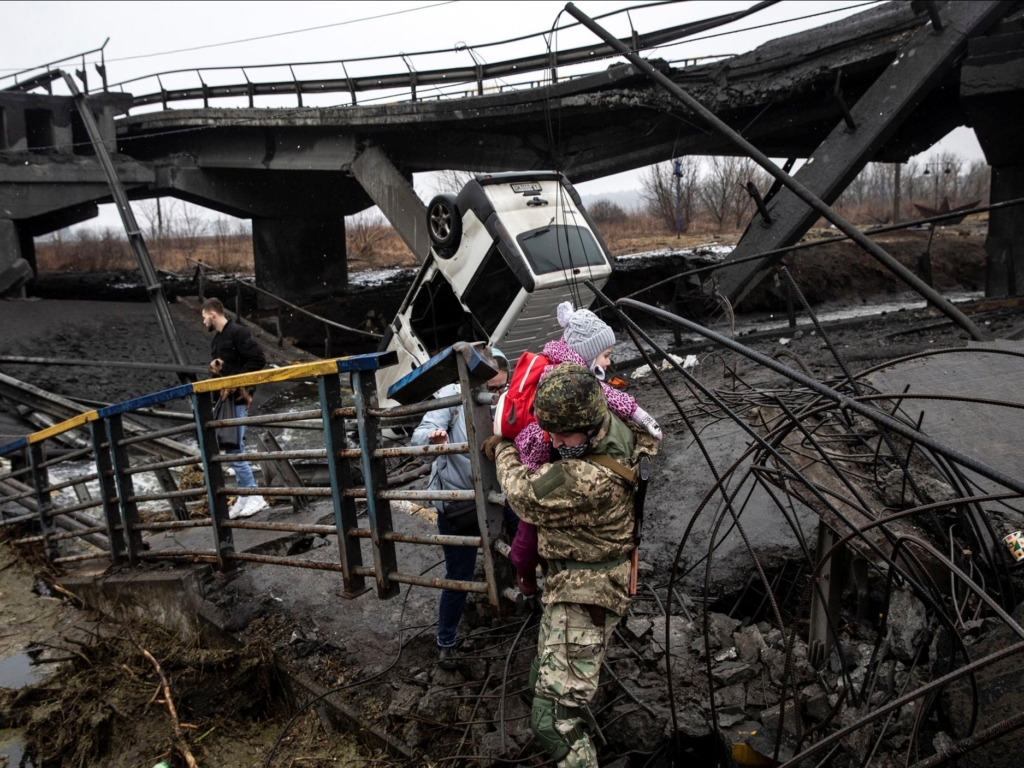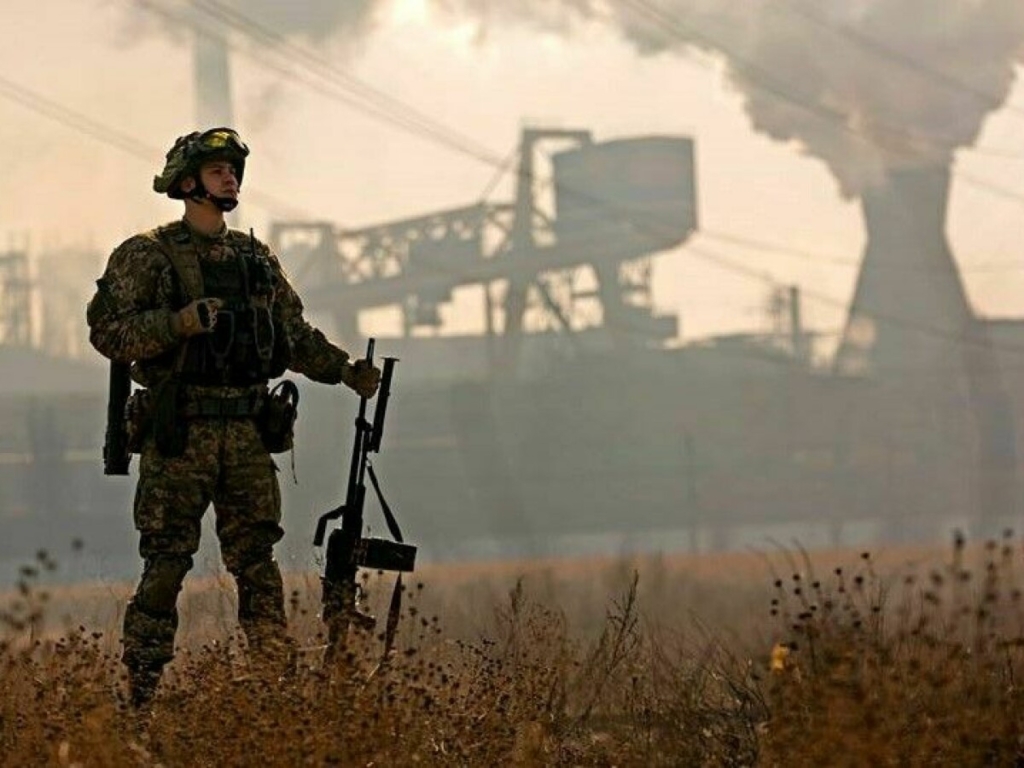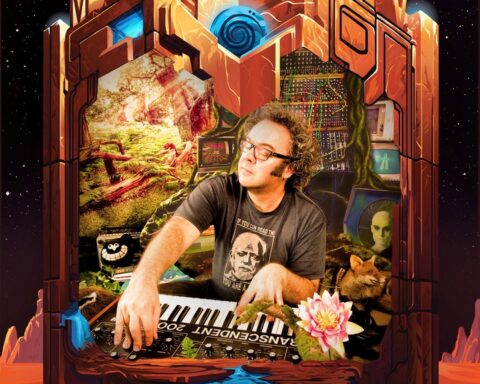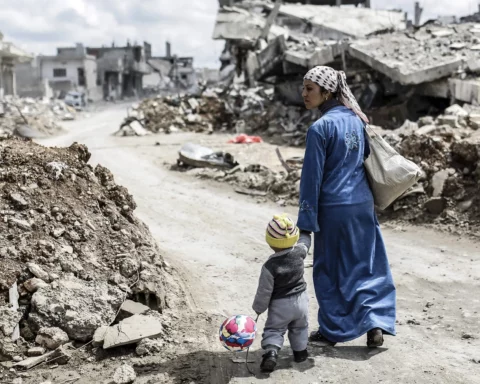War transforms everything – we are suddenly for or against armies, revolutionaries become soldiers, coalitions monopolize politics, patriotic fervor swells, and the party of order triumphs. When the Russian army invaded Ukraine last week, Putin claimed it was in the name of “denazification,” evoking the important role “anti-fascism” plays in the ideology of the Russian state. In the following text, published in Liaisons’ first book In the Name of the People, a friend from the region offers an account of revolutionaries involved in the 2014 Maidan uprising in Ukraine, along with considerations about the particular history of Russian “anti-fascism.” Our friend has also recently put together a site with writing on the ongoing events in Ukraine, with more articles to come. While the following text does not address the current invasion, it offers an important history of the present moment (the Winter Uprising, Anti-Maidan, the annexation of Crimea) and imagines other possible histories between Russian and Ukrainian people.
Liaisons- more than a collective, less than a world, is an inclination, a tangent, a crossroads of confrontations, encounters, and links, with authors from the United States, France, Italy, Japan, Korea, Lebanon, Mexico, Quebec, Russia, and Spain.
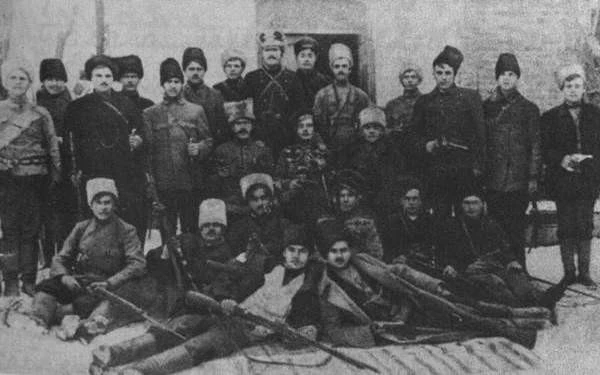
On a warm summer evening in Kiev, my friend told me a story about his grandfather. The story takes place during World War II in Ukraine. As a peasant, his grandfather found himself in German-occupied territory after yet another German offensive. His grandfather wanted to fight Nazis, but needed to figure out how. There were two options: he could stay in occupied territory and look for a partisan unit, or could try to join the Red Army. He decided to find the partisans, which is how he stumbled upon a strange unit fighting the Germans. The story doesn’t mention how, but he figured that these were Makhnovists, followers of Nestor Makhno, the commander of the Revolutionary Insurrectionary Army of Ukraine, also known as the Anarchist Black Army, who led a guerrilla campaign in southern Ukraine against other factions seeking to exercise authority over the territory (Ukrainian nationalists and German and Russian forces).
My friend told me how his grandfather would vividly recount how he decided to stay as far away from them as he could, because those people would be crushed by both the Nazis and the Reds. The chances of survival in such a battalion were virtually non-existent.
Very little is known about this battalion today, but it was likely led by Ossip Tsebry – a well-known Makhnovist who fled from the Bolsheviks in 1921. In 1942, Tsebry returned to Ukraine in an attempt to build an anarchist partisan movement to fight both Nazis and Bolsheviks. While little is known about it, this unit did exist and was eventually defeated by the Nazis. Tsebry was captured and ended up in a concentration camp, then was liberated in 1945 by the Western Allies, and subsequently managed to escape the Bolsheviks once again.
We remembered Tsebry at the dawn of the fall of 2014. Russia had already annexed Crimea and was advancing troops in Donbass. At that moment, no one would have been surprised to hear that Russian tanks were moving on Kharkov, Odessa, or even Kiev. I had just arrived from Saint Petersburg, where I had seen how Russian society would actually fully support the invasion. There was no antiwar movement in sight, and as we exchanged words of remembrance among friends, our emotions matched the intensity of the situation.
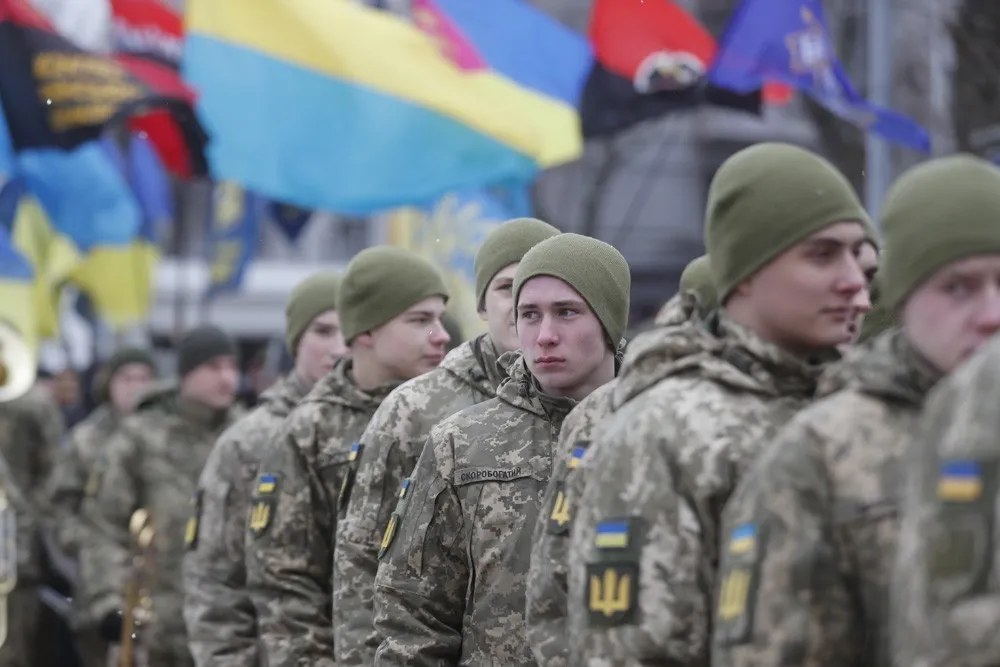
Troubled Waters
In the time that followed, the discussions revolved almost entirely around fascism and anti-fascism. All the other debates were overshadowed by the question: who is fascist and who is anti-fascist? Since the beginning of the Ukrainian uprising, Russian state propaganda stealthily resurrected the old Soviet vocabulary, declaring that those who were part of the movement were either fascists or Nazis, or were at least manipulated by them. Anarchists and leftists from Ukraine responded by noting that the Russian state is actually the region’s most fascist state. “Fascist” volunteer battalions and the “fascist” Donetsk People’s Republic (DNR) were all over the news. Anti-fascists from Belarus and Ukraine, Spain and Italy, Brazil and God knows where else all went to fight. Some ended up on one side and some on the other.
Berkut is the most brutal unit of the Ukrainian riot police. At first, Western leftists, seduced by images of Soviet Berkut buses ablaze on the icy streets of Kiev, largely supported Maidan. But when they realized that the diagonal black and red flags were actually those of the fascists, they had a sudden change of heart and started supporting the “anti-fascist popular uprising” in the East. And then they saw VICE’s feature about pro-Russian anti-fascists, who actually turned out to be fascists. This was all a bit too complicated for them, so they turned away from the Ukrainian situation all together. Yet the West was not the only site of confusion. Anarchists and leftists from Russia were arguing to death over who exactly was fascist and anti-fascist in Ukraine, as if this could explain everything and summarily resolve the matter at hand.
No one had any clear idea of what to do in fact, even on the ground. We were all desperately looking for guidance, especially in stories from the past. But the reality of war, and the general mobilization it entails, was not an object of analysis for us. Most of us grew up with the feeling that war wouldn’t happen here. We felt like these things could only happen on the periphery – a space that we usually ignored or to which we gave little attention. The only war story we were familiar with was the story of the Great Fatherland War, also referred to as the Great Patriotic War, the Great Fatherland War is a literal translation of the name given to the part of World War II that was fought in the Soviet Union. That story, like all myths, was clear and self-explanatory. There wasn’t much to debate, which made the war a powerful tool for manufacturing unity. That is how my friend and I came to remember the story of Ossip, today a story so neglected and forgotten.
The Grandfather’s War
Our generation, which came into the world near the end of the Soviet Union, still remembers the myth of the Great Fatherland War. When we were children, we played at war – and it was always the same war. It was a war between us and the bad guys, the German fascists. We knew our enemy from the old Soviet movies. The new streets of my neighborhood, built in the eighties, were named after Soviet war heroes, and in the street you could never escape all the monuments of the great Red Army and the martyrs of the war. Some of our cities were even considered “heroic cities.” My grandfather was a veteran, and for big events, he would proudly take out his medals to wear.
During the nineties, when the news was filled with strange camouflaged men with guns, I couldn’t connect these images with the story of my grandfather and the monuments to the heroes. That war – the war of all the movies and the songs – was the sacred war. That war was full of heroism and purity. What we saw on television just seemed like a nameless bloodbath, a war full of confusion.
In “the country that defeated fascism,” oddly enough, no serious theory of fascism ever emerged. For the common Soviet citizen, fascism just meant the epitome of evil and abjection. But in the subculture of prison gangs, for example, tattoos of swastikas and other Nazi insignia were considered symbols of a radical denial of the state. These symbols did not have the same meaning in the West, and in Russia, anti-fascism came to mean something different.
This difference was a question of onomastics, established first through the act of giving a name. In the Soviet Union, World War II was called the Great Fatherland War, and was considered, in Soviet historiography, as part of the eternal fight to defend the fatherland. The term “Fatherland War” is a name that was already used during Napoleon’s invasion of Russia. In the late thirties, and even more so during the war, Stalin and his propagandists began to speak of Soviet history within the wider historical context of the Russian Empire. This propaganda constructed the narrative of an unending struggle against the invaders from the West: from Alexander Nevsky in the thirteenth century to the Napoleonic invasion in 1812. This glorification of feudal and aristocratic heroes would have been impossible to imagine even a few years before, but, for the purposes of mobilization, of course it wouldn’t hurt to sacrifice a few principles. Because who, if not we, the Great Russian People, could smash fascism and liberate Europe? As the war dragged on, it became not only a fight against fascism, but a war against that insistent invader, who arrived again and again to conquer our sacred Russian land.
According to this logic, the enormous human losses during the war were not due to the failures of the Soviet state, but were a martyrdom of necessity. They were a sacrifice that fits comfortably within the old story of the God-chosen Russian Nation, humbly taking on the burden of others and saving Europe from eschatological disasters, again and again.
In the context of the repression of the thirties, ethnic deportations were massive. As this trend continued during the war, the deportations were justified through accusations of Nazi collaboration. Russian ideologists love to mention collaborator units formed by Nazis during the war, composed of different Soviet ethnic groups. By creating the figure of Traitor-Nations, they are able to omit the fact that most collaborators were actually ethnic Russians, in order to legitimate colonial politics and ethnic repression.
Through this revisionism, the state has successfully created an equivalency between the Soviet subject and the anti-fascist. By essence, a Russian is anti-fascist, and thus being against Russians means being fascist. Anybody standing against Moscow for any reason now became fascist by default. In this framework, victory could only be achieved through national unity, and being Russian meant being loyal. Now any protest against central power could be easily reframed in these simplistic terms.
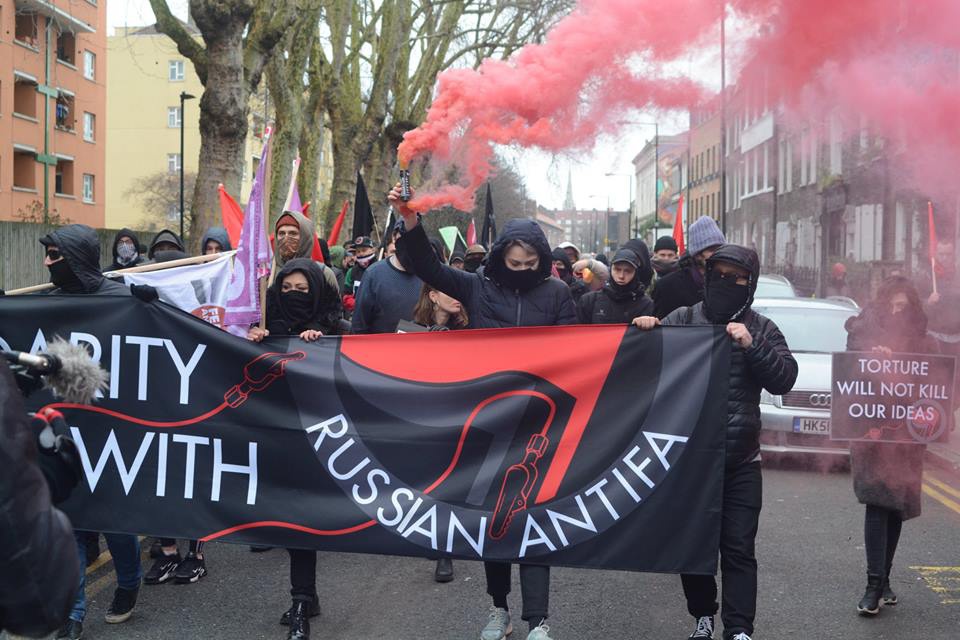
Russian Antifa and State Anti-fascism
While it has lost some momentum, in the 2000s, the Antifa movement was a significant mobilizing force for Russian youth. While it was a very heterogeneous movement, what its members held in common was the beautiful but not always well-calibrated desire to smash Nazis. The more this movement focused on the practical aspects of attacking the Right, the less it could propose any kind of significant theoretical framework to analyze fascism. What is worse is that its members often just ended up naming “fascist” anything they didn’t like. This was the case for the gangs of youth coming from the Caucasus. These gangs not only challenged their hegemony in the streets, but also showed “a lack of will to integrate” and accept the power of Russian culture in the “historically” Russian cities. “Black racism” or “Caucasian fascism” became widespread terms within the Antifa milieu. A significant part of the milieu even had no problem calling themselves “patriots” and Nazis “spoiled Russians” who forgot their roots. As one of the most popular songs of the milieu proudly proclaimed: “I am the real Russian / You are just a Nazi whore.” This song, “What We Feel,” was composed by the band Till the End, and features the band Moscow Death Brigade.
Consequently, these milieus could not produce any alternative vision of history that could pose a challenge to that of the state. They just repeated mindless mantras about the strange character of fascists and Nazis in the “country that defeated fascism,” and bragged about having a grandfather who went to war.
Elaborating other narratives and representations, they believed, could undermine their reach and separate them from the “common people.” They tried as much as possible to look and act ordinary. They wanted to distance themselves from any form of marginality. Some even assumed an avant-garde role among the “healthy” part of Russian society. Given the commonplace of this populist strategy, it isn’t surprising that some of them began to sympathize with imperialist ideas, or even went to fight for the “Russian World” in Donbass.
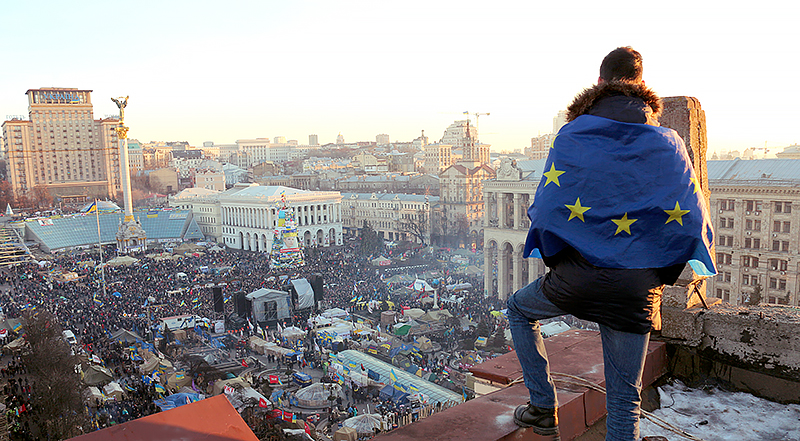
The Russian Spring vs. Maidan
The 2014 Winter Uprising in Ukraine was deep and long. When former president Viktor Yanukovych ran away, the vast majority of those who took part in the movement were ready to stay in the streets to expand the Revolution of Dignity (the official Ukrainian name of the events).
Vladimir Putin’s regime was in a delicate position. It had been dealing with a weak economy since 2012, and was still weakened by the protest cycle of 2011–2012. A protest movement so close to Russia’s borders, and a successful one at that, wasn’t a welcome event, but the regime had managed to create an internal unity and delegitimize every uprising and resistance. The Maidan events were not yet over when Russia annexed Crimea, creating a de facto war where there was a “popular” uprising and sending a message to neighbors that uprisings could weaken their country and make it easy prey for annexation.
The annexation of Crimea was met with a spectacular wave of nationalist euphoria. Since the independence of Ukraine in 1991, Crimea had been first on the list of territories to reclaim for Russian nationalists. After 2014, Krymnash, meaning “Crimea is ours,” became both a meme and foundation for a new imperial consensus.
Two other important terms also appeared at that moment, although they are now all but forgotten: “Russian Spring” and “Russian World.” Russian Spring was a direct reference to the Arab Spring, which Russian ideologists had declared, with the utmost seriousness, was nothing more than a special CIA operation against legitimate leadership in the Arab world. But the Russian Spring should have been the authentic uprising of the Russian People, willing to reunite under their leader and state as a part of the Russian World. As this potentially refers to any place and land historically related to Russia or with a significant Russian-speaking population, the scope of the so-called Russian World has always been unclear.
As with every populist idea, the Russian World was presented as something natural and self-evident – it was completely natural for Russian speakers to want to be annexed by the Fatherland. Through this discursive operation, it was not a question of the Russian Empire (re)conquering territories, but of the Russian people liberating themselves from the alienating rule of the West and coming back to the homeland. Apparently it was just like World War II, when the Red Army did not conquer new territories in Europe and Asia, but liberated these people from the yoke of fascism.
Through this lens, the annexation of Crimea simply became a “reunion,” a manifestation of the unanimous will of the Crimean people to return to their homeland. Those who were not part of that consensus – like the native Crimean Tatars, for instance, who were well-organized and protested the annexation – were simply ignored or seen as traitors. After the annexation, all the leftists, activists, and anarchists had to escape. Those who remained either ended up in jail, or just disappeared after a raid. Every public political activity became impossible. It’s Russia, after all, and Russia means war.
The People’s Anti-Fascist Uprising
Different tactics were used to give the occupation of Crimea and Donbass the appearance of popular movements. In Crimea, where Russia has large military bases, it was easy to fill the peninsula with soldiers in a few days. These forces rapidly took over the most important infrastructural points, such as the parliament and the airport, after which they adopted an “observer” role to appear as a “peacekeeping” force to ensure that the “people’s uprising” went smoothly, and that Russian-speaking populations were not “attacked.”
In a disconcerting game of mirrors, pro-Russian forces started to copy the tactics used at Maidan. In the first days of the annexation, the “self-defense forces” of Crimea were created, copying the self-defense forces of Maidan. Officially, they were created by locals who wanted to defend their cities from the Nazi hordes allegedly arriving from Kiev. Of course, it was quickly shown that these self-defense militias were controlled by Russian officers. They were composed of Cossacks, local petty criminals, pro-Russian right-wingers, and red-brown activists from Russia. In reality, the self-defense groups and the Russian military operated together. During the assaults, plainclothes self-defense officers were performing all the actions, to portray for the media an image of the people’s revolt. The soldiers were never far away, ready to step in if the Ukrainian security services or army intervened. This tactic contributed to creating the simulacrum of a peaceful and voluntary annexation.
The foundations of this communications strategy were laid during Maidan, while the Anti-Maidan movement grew in the eastern cities of Ukraine. At the core of this movement were pro-Russian groups, already familiar with Russian-imperial ideas. Anti-Maidan named itself an anti-fascist movement and repeated Russian propaganda’s main clichés. Anti-Maidan’s discourse was the inverse of Maidan: there were calls to join Russia, reinstall Yanukovych to power, celebrate the Berkut, and invite Russian troops to occupy the country. At the same time, there were also other people participating in Anti-Maidan – people who genuinely believed that a motley coalition of Nazis, homosexuals, and the American “deep state” had joined forces and seized power in Kiev.
At the beginning, Anti-Maidan presented itself as another movement against Maidan. One street demonstration against another street demonstration, occupations of state buildings against other occupations, one constitutive violence against another. On the ground, however, the realities of the two movements could not be further apart. In Donetsk and Luhansk, the Anti-Maidan movement acted with the support of local bureaucrats, the police, and organized crime. While Maidan was repressed, Anti-Maidan had free reign, and it helped the pro-Russians gain a significant number of official buildings and arms. “People’s Assemblies,” controlled by armed activists, elected “popular representatives.” “People’s Republics” were proclaimed, calling on Russian troops and holding referendums about joining the Russian Federation. Like in Crimea, all the key positions in these so-called republics were swiftly occupied by special officers and loyal activists sent by Moscow. The so-called uprising was over at that point, and a new life began in these “liberated” territories.
It is worth noting that when the clashes first started, when people were facing each other at the barricades, they often realized they had more in common than they thought. In Kharkiv, for instance, Anti-Maidan and Maidan camps stood in front of each other on Freedom Square. Maidan invited its opponents to come speak at the microphone to let them explain what they stood for, and in many instances people changed their minds and switched sides. This naturally upset radical nationalists from either side, who sought an image of a people’s uprising, complete with its sacrificial victims. All that was a far cry from the mundane meetings, interminable conversations, and socializing that went on at the square.
To demonstrate which movement was a real “people’s movement,” both sides competed for hegemony in the street. This made clashes and provocations inevitable and increasingly violent. After the events of May 2, 2014, in Odessa, where more than 40 people died in a fire during clashes between Anti-Maidan and Maidan, and the start of the war in the East, protests in the streets stopped and many Anti-Maidan organizers went to Russia or the new “People’s Republics.”
Nevertheless, the project of establishing Novorossiya, an old colonial Russian name for some regions of Ukraine that were supposed to be reunited with the fatherland, was soon abandoned. The attempts to reproduce the “people’s uprising” coordinated in Luhansk and Donetsk failed elsewhere, despite major Russian financial and media support. What remained, however, and continued to circulate, was the narrative of the popular uprising. With the help of the already familiar paradigm of the Russian Spring, the Donbass uprising was declared to be “anti-fascist.” It didn’t seem to bother anyone in Russia that the leaders of this “people’s uprising” were composed of officers fresh from Moscow. After all, they were pursuing the mission of the Red Army: save the people from fascism and the machinations of the West.
Anti-fascism is the key idea that bridges the old monarchist empire, the Bolshevik superpower, and the new Russian State: a world power that keeps getting stronger despite the intrigues of its enemies.
In this context, it’s no wonder the war in Ukraine didn’t incite large protests in Russia. On the contrary, the streets were filled with tents of solidarity associations collecting goods and money for the people’s militias of Donbass. May 9, known as the Day of Victory, became the main state celebration in Russia. It consisted of parades, fireworks, people’s marches, children who wore Red Army costumes and chanted slogans like “To Berlin, To Kiev, to Washington!” and “Thank you grandpa for the victory!” The conflict in Ukraine was seamlessly converted into an element of the narrative of the new imperial consensus.
After 2014
Like most contemporary insurrections, Maidan took political milieus by surprise on both sides of the border. The Russian, Belarusian, and Ukrainian activist networks have always been in close contact, and though Ukraine was considered to have more liberty and less repression, the social situation was no less difficult than elsewhere. Yanukovych was trying to consolidate power and resources while at the same time imposing neoliberal reforms. When comrades from different countries met, we sadly joked that Ukraine would soon be like Russia, Russia soon like Belarus, and Belarus soon like North Korea. It seemed like things could do nothing but get worse. If somebody had proposed on New Year’s Eve of 2014 that Maidan would become one of the biggest uprisings of the last decades in Eastern Europe, they would have been met with waves of laughter.
In the beginning, leftists and anarchists did not really believe in the perspectives opened by the movement. Some recalled the Orange Revolution of 2004 as a fool’s trap that would only change the faces one sees on television. Others wanted to avoid getting paralyzed by over-analysis, and thought it important to take part in any popular initiative. And effectively, this is what Maidan was. In its experience, aesthetics, and composition, it consisted of a “popular” uprising.
Most of us, undecided, decided to wait. Our uneasiness came from strange slogans about “Euro-association,” as well as the presence of the Far Right and neo-Nazis. And while the Right was not setting the agenda of the movement, it was better organized and was boldly trying to exclude its enemies from the square. All leftist symbols were seen as a positive reference to the Soviet Union, thus pro-Russian and pro-Yanukovych. As for the anarchists and other radicals, they weren’t organized enough to participate as a distinct group.
By the end of December, the movement had grown but did not present new developments. It seemed condemned to be an endless encampment of cold weather and boredom. But in mid-January, the regime decided to scale up repression – emergency laws were adopted and the occupation was brutally attacked, causing several casualties. After the attack, the situation changed dramatically, becoming a struggle against a real dictatorship. Leaving their doubts behind, the radical milieus joined the movement.
They were rapidly joined by comrades from neighboring countries. We saw with our own eyes how Maidan’s “Russophobia” was an invention of the Russian media. It didn’t really exist. It didn’t bother anyone to speak Russian at the barricades, even with the strongest Moscow accent. Some people joked that you might be a spy, but then usually added: “We will meet at the barricades in Moscow chasing off Putin!”
Maidan grew by waves, adopting more radical methods as more and more people got involved. From field kitchens to underground hospitals, fight trainings to lectures and film screenings, and transportation to distribution and supplies, a huge infrastructure was growing up around the protests. There were even attempts to compose decision-making structures, in the form of soviets or assemblies, but they didn’t have time to take root. The Berkut started to openly shoot people in Kiev, and in February the insurrection spread throughout the country. People were occupying administrative buildings and everywhere blockading the police. The regime attempted a last push, but overestimated its forces and failed, and then Yanukovych was forced to flee to Russia.
In appearance, Maidan had won. An enormous amount of people in Ukraine gained experience in autonomous organizing and street sensibility, and sacrifice did not befall them in vain. People felt like the game had changed, and they could now take hold of a common power.
But, in anarchist and leftist circles, this euphoria soon died. Thanks to the efforts of the liberal and Russian media, however opposed they were in their ends, the Right was able to portray the image that it was the radical vanguard of Maidan. Among many of us, joy gave way to panic as those whom one might have fought on the street the day earlier had now suddenly gained official posts in the new structures of state power.
Something far more dreadful was on the way. Russia annexed Crimea and started a war, which was an ambiguous gift for the new government. The energy set free on Maidan was channeled into volunteer battalions and support for the ruined Ukrainian army, which couldn’t do much against Russia. From now on, defending the Revolution of Dignity didn’t mean being on the barricades of Kiev, but on the front line. The movement then disappeared, of course, as it is obviously wrong to protest when your country is at war.
As for the Russian leftists, they found themselves on the side of Russian propaganda, and began to increasingly criticize “Ukrainian fascism.” Well-known figures like Boris Kagarlitsky started spreading stories about an “anti-fascist proletarian popular uprising in Donbass.” Some of these leftist personalities could be seen drinking tea with Russian nationalists and imperial fascists at the next meeting for the Russian World in Crimea. The young went to war as volunteers, if not to bomb villages, then at least to take some selfies in camouflage, Kalashnikov in hand. Others became war journalists, following battalions like the Prizrak brigade in Donbass, whose leader, after rounding up a few well-known neo-Nazis, became famous for defending the idea of raping women who weren’t home after curfew. None of this seemed to bother the Left, as long as the battalions kept waving red flags and singing songs from that sacred war, complemented by stories about NATO soldiers on the Ukrainian side and images of dead children. As for the older Western leftists, they found themselves reliving the Cold War and started support campaigns for the “anti-fascists of Donbass.”
After the shock of the first months, most of the Russian radical milieus turned away from such a confusing situation. Either the issue of the war did not concern them, or they felt there was nothing they could do. There was also a new wave of repression in Russia, within a context of unprecedented support for Putin. In this situation, there was increasingly less public political activity, and more comrades turned to infrastructural projects like cooperatives or publishing. Others decided to immigrate, either within Russia or abroad.
In Ukraine, on the other hand, organizing was on the rise. Despite the war, political life was blooming, but things were shifting fast. The Antifa and punk milieus generally became patriotic right-wingers. Anarchists weren’t spared from this dynamic, many of whom grew sympathetic to the “autonomous nationalists” of Autonomous Resistance, an ex-Nazi group from the barricades of Maidan that was now spreading a mix of anti-imperialism and concepts taken from the new Right. Following their logic, nationality was the same as class, and ethnic conflicts and even cleansing could be understood as a form of class war. They saw the war with Russia as an anti-imperialist struggle, supported the army, and applauded their members who went to war as heroes. Others followed a similar path. Though they started by unmasking the fascist character of the Russian state, they ended up arguing that the only valid strategy against the Russian invasion was to support the Ukrainian Army. By evoking the history of World War II, they mirrored the logic of Russian propaganda, accusing anyone who criticizes the Ukrainian government of being pro-Russian or, of course, “fascist.”
Another part of the movement decided that, again in reference to World War II, when faced with absolute evil, it was better to collaborate with the devil. In today’s terms, Russia was the obvious evil, and therefore collaboration came in the form of joining the Ukrainian Army or the volunteer battalions – in the end, supporting the government institutions. There were some of our now ex-comrades who went to war, or at least supported such a decision. It is certain that no one wanted to become cannon fodder for capitalists and the state. But, for some of them, it seemed like the only option left to fight the Russian invasion and the Russian machine. The most naive sincerely believed in the revolutionary nature of the people, and for a moment really thought they could agitate among the soldiers, convincing them to turn their guns against the government. The most cynical spoke about the opportunity to “gain war experience,” while others just felt pressure and the need to do something. With their support of armed struggle against the military invasion, part of the movement drifted toward a fascination for anything military. They seemed hypnotized by a new world of Kalashnikovs and camouflage, in contrast with which everything else just seemed to fade from view.
The topic of war soon became dangerous to address. The propaganda was working not only in Russia but also in Ukraine. While those who argued against the war could quickly be labeled as Putin’s agents, it also became illegal to make public statements against military mobilization.
A lot of people simply became tired of all the conflicts and left the movement. The country’s economic crisis forced people to work more, snatching away their time. While the energy of Maidan continued to nourish autonomous projects, stagnation struck the heart of the movement at the same time Ukrainian society was in crisis and the government still hadn’t completely regained control of the situation.
Other Histories
In retrospect, it seems the movement failed to find a way to oppose the rising populist imperialist consensus, both in Russia and in Ukraine. And for this not only our weakness, but also the way we have defined priorities in these last years, are to blame.
Too busy fighting fascists and Nazis in the street, we did not develop a solid analysis of what fascism is, nor did we propose an alternative to the official history of World War II, which seems to haunt us at every turn. At the level of rituals and symbols, we finally followed the version advanced by the Russian state – the myth of the unity of the Soviet People against fascism. The narratives about other forces that confronted both Stalinism and Nazism – like those of the partisan movement that rejected the rule of the Red Army – have become marginal. We have likewise paid too little attention to the conflicts of peasants and workers against Stalinism, or to the Gulag insurrections during the war.
On the other hand, we also must rethink the colonial character of the Russian and Soviet empires. Armed conflicts in distant places have so easily been forgotten. Even the war in Chechnya, which was important for anarchists in the 1990s and at the beginning of the 2000s, was forgotten by the next generation. We are in dire need of internal structures that allow us to transmit such experiences and their lessons.
In this light, it’s not surprising that the explosion of war in Ukraine took us by surprise. We have not fully taken account of the fact that Russia is always at war somewhere, in some part of the world. And now this war knocks at our own door, and threatens our comrades and neighbors. It attacks our friends. We no longer know what common ground can establish connections between our movements, especially at the moment we need it most.
It seemed to us, as Russians and Ukrainians, that we almost lived in the same space, with a close past and present. We shared our experiences and resources in our struggle against common hardships. Yet when our states plunged us into war, feeding off the myths of our common past, we didn’t know how to resist. The more they try to mobilize the dead to divide us, the more we should show that history can’t be reduced to what is written by the victors. We ourselves have histories to tell – a story beyond imperialist myths, however they’re assumed – because only revolutionary history will keep us warm during this long winter.
__________
